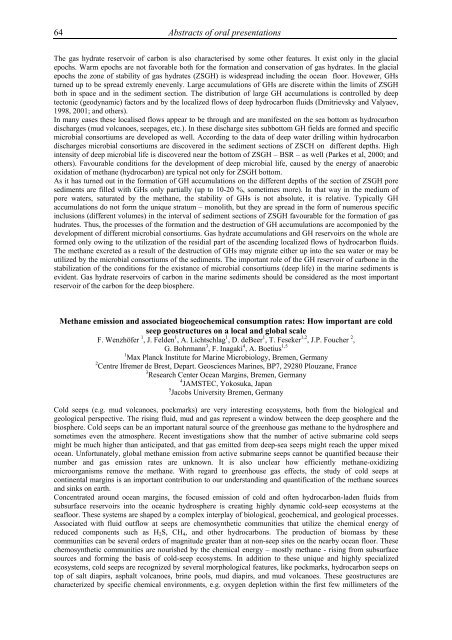Ninth international conference on - Marum
Ninth international conference on - Marum
Ninth international conference on - Marum
You also want an ePaper? Increase the reach of your titles
YUMPU automatically turns print PDFs into web optimized ePapers that Google loves.
64<br />
Abstracts of oral presentati<strong>on</strong>s<br />
The gas hydrate reservoir of carb<strong>on</strong> is also characterised by some other features. It exist <strong>on</strong>ly in the glacial<br />
epochs. Warm epochs are not favorable both for the formati<strong>on</strong> and c<strong>on</strong>servati<strong>on</strong> of gas hydrates. In the glacial<br />
epochs the z<strong>on</strong>e of stability of gas hydrates (ZSGH) is widespread including the ocean floor. Hovewer, GHs<br />
turned up to be spread extremly enevenly. Large accumulati<strong>on</strong>s of GHs are discrete within the limits of ZSGH<br />
both in space and in the sediment secti<strong>on</strong>. The distributi<strong>on</strong> of large GH accumulati<strong>on</strong>s is c<strong>on</strong>trolled by deep<br />
tect<strong>on</strong>ic (geodynamic) factors and by the localized flows of deep hydrocarb<strong>on</strong> fluids (Dmitrievsky and Valyaev,<br />
1998, 2001; and others).<br />
In many cases these localised flows appear to be through and are manifested <strong>on</strong> the sea bottom as hydrocarb<strong>on</strong><br />
discharges (mud volcanoes, seepages, etc.). In these discharge sites subbottom GH fields are formed and specific<br />
microbial c<strong>on</strong>sortiums are developed as well. According to the data of deep water drilling within hydrocarb<strong>on</strong><br />
discharges microbial c<strong>on</strong>sortiums are discovered in the sediment secti<strong>on</strong>s of ZSCH <strong>on</strong> different depths. High<br />
intensity of deep microbial life is discovered near the bottom of ZSGH – BSR – as well (Parkes et al, 2000; and<br />
others). Favourable c<strong>on</strong>diti<strong>on</strong>s for the development of deep microbial life, caused by the energy of anaerobic<br />
oxidati<strong>on</strong> of methane (hydrocarb<strong>on</strong>) are typical not <strong>on</strong>ly for ZSGH bottom.<br />
As it has turned out in the formati<strong>on</strong> of GH accumulati<strong>on</strong>s <strong>on</strong> the different depths of the secti<strong>on</strong> of ZSGH pore<br />
sediments are filled with GHs <strong>on</strong>ly partially (up to 10-20 %, sometimes more). In that way in the medium of<br />
pore waters, saturated by the methane, the stability of GHs is not absolute, it is relative. Typically GH<br />
accumulati<strong>on</strong>s do not form the unique stratum – m<strong>on</strong>olith, but they are spread in the form of numerous specific<br />
inclusi<strong>on</strong>s (different volumes) in the interval of sediment secti<strong>on</strong>s of ZSGH favourable for the formati<strong>on</strong> of gas<br />
hudrates. Thus, the processes of the formati<strong>on</strong> and the destructi<strong>on</strong> of GH accumulati<strong>on</strong>s are accomp<strong>on</strong>ied by the<br />
development of different microbial c<strong>on</strong>sortiums. Gas hydrate accumulati<strong>on</strong>s and GH reservoirs <strong>on</strong> the whole are<br />
formed <strong>on</strong>ly owing to the utilizati<strong>on</strong> of the residial part of the ascending localized flows of hydrocarb<strong>on</strong> fluids.<br />
The methane excreted as a result of the destructi<strong>on</strong> of GHs may migrate either up into the sea water or may be<br />
utilized by the microbial c<strong>on</strong>sortiums of the sediments. The important role of the GH reservoir of carb<strong>on</strong>e in the<br />
stabilizati<strong>on</strong> of the c<strong>on</strong>diti<strong>on</strong>s for the existance of microbial c<strong>on</strong>sortiums (deep life) in the marine sediments is<br />
evident. Gas hydrate reservoirs of carb<strong>on</strong> in the marine sediments should be c<strong>on</strong>sidered as the most important<br />
reservoir of the carb<strong>on</strong> for the deep biosphere.<br />
Methane emissi<strong>on</strong> and associated biogeochemical c<strong>on</strong>sumpti<strong>on</strong> rates: How important are cold<br />
seep geostructures <strong>on</strong> a local and global scale<br />
F. Wenzhöfer 1 , J. Felden 1 , A. Lichtschlag 1 , D. deBeer 1 , T. Feseker 1,2 , J.P. Foucher 2 ,<br />
G. Bohrmann 3 , F. Inagaki 4 , A. Boetius 1,5<br />
1 Max Planck Institute for Marine Microbiology, Bremen, Germany<br />
2 Centre Ifremer de Brest, Depart. Geosciences Marines, BP7, 29280 Plouzane, France<br />
3 Research Center Ocean Margins, Bremen, Germany<br />
4 JAMSTEC, Yokosuka, Japan<br />
5 Jacobs University Bremen, Germany<br />
Cold seeps (e.g. mud volcanoes, pockmarks) are very interesting ecosystems, both from the biological and<br />
geological perspective. The rising fluid, mud and gas represent a window between the deep geosphere and the<br />
biosphere. Cold seeps can be an important natural source of the greenhouse gas methane to the hydrosphere and<br />
sometimes even the atmosphere. Recent investigati<strong>on</strong>s show that the number of active submarine cold seeps<br />
might be much higher than anticipated, and that gas emitted from deep-sea seeps might reach the upper mixed<br />
ocean. Unfortunately, global methane emissi<strong>on</strong> from active submarine seeps cannot be quantified because their<br />
number and gas emissi<strong>on</strong> rates are unknown. It is also unclear how efficiently methane-oxidizing<br />
microorganisms remove the methane. With regard to greenhouse gas effects, the study of cold seeps at<br />
c<strong>on</strong>tinental margins is an important c<strong>on</strong>tributi<strong>on</strong> to our understanding and quantificati<strong>on</strong> of the methane sources<br />
and sinks <strong>on</strong> earth.<br />
C<strong>on</strong>centrated around ocean margins, the focused emissi<strong>on</strong> of cold and often hydrocarb<strong>on</strong>-laden fluids from<br />
subsurface reservoirs into the oceanic hydrosphere is creating highly dynamic cold-seep ecosystems at the<br />
seafloor. These systems are shaped by a complex interplay of biological, geochemical, and geological processes.<br />
Associated with fluid outflow at seeps are chemosynthetic communities that utilize the chemical energy of<br />
reduced comp<strong>on</strong>ents such as H2S, CH4, and other hydrocarb<strong>on</strong>s. The producti<strong>on</strong> of biomass by these<br />
communities can be several orders of magnitude greater than at n<strong>on</strong>-seep sites <strong>on</strong> the nearby ocean floor. These<br />
chemosynthetic communities are nourished by the chemical energy – mostly methane - rising from subsurface<br />
sources and forming the basis of cold-seep ecosystems. In additi<strong>on</strong> to these unique and highly specialized<br />
ecosystems, cold seeps are recognized by several morphological features, like pockmarks, hydrocarb<strong>on</strong> seeps <strong>on</strong><br />
top of salt diapirs, asphalt volcanoes, brine pools, mud diapirs, and mud volcanoes. These geostructures are<br />
characterized by specific chemical envir<strong>on</strong>ments, e.g. oxygen depleti<strong>on</strong> within the first few millimeters of the














